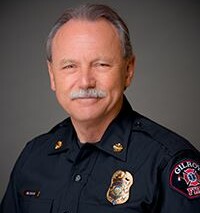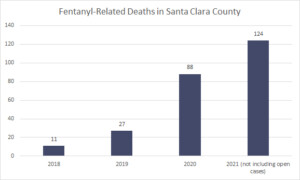Guest column by Jim Wyatt: Local young people need to be aware of the risk of using fentanyl drugs
People in the county are dying of a powerful illegal drug
![]()
By Jim Wyatt

Jim Wyatt
A mom recently told me the tragic story of how she lost her son. His name was Tosh. He was a kind, good-hearted, and intelligent 29-year-old young man with a bright future. He had been to the doctor for a persistent allergy that caused his skin to exhibit itchy hives. One night, Tosh took a Benadryl for his symptoms and about a quarter of a Xanax pill to help him sleep. He had purchased the Xanax from an acquaintance he knew and trusted. Tosh never woke up, and his girlfriend found him dead the next day. He died because the Xanax he took was counterfeit. It was laced with a fatal dose of a powerful synthetic opioid called fentanyl.
Many people may not realize that prescription-type drugs are being sold on the streets or through social media in our community. These drugs may contain some or all of the drug that they purport to be, but we’re finding that most of them are now laced with fentanyl.
 We started hearing about fentanyl and its effects on communities on the East Coast about seven years ago. Since then, the issues have crept to the West Coast, with deaths rising dramatically in our county over the past three years. According the Santa Clara County District Attorney’s Office, 88 deaths in the county were caused by fentanyl in 2020. In 2021, there were 124. At the same time, Gilroy suffered nine deaths from opioid overdose/poisonings in 2021, ranging from as young as 13 to age 77. And of those nine, five were attributed to fentanyl.
We started hearing about fentanyl and its effects on communities on the East Coast about seven years ago. Since then, the issues have crept to the West Coast, with deaths rising dramatically in our county over the past three years. According the Santa Clara County District Attorney’s Office, 88 deaths in the county were caused by fentanyl in 2020. In 2021, there were 124. At the same time, Gilroy suffered nine deaths from opioid overdose/poisonings in 2021, ranging from as young as 13 to age 77. And of those nine, five were attributed to fentanyl.
Public Meeting on Fentanyl Use
Fentanyl tends to be a problem in two ways. Firstly, it is a synthetic opioid that is highly addictive. It is 50 to 100 times more powerful than heroin. So for persons looking for a high, they purchase fentanyl and either purposefully or unknowingly increase the dosage to a fatal amount. Secondly, fentanyl is being added to pills that wouldn’t typically contain fentanyl. Persons buying pills like Xanax, OxyContin, or ecstasy from unreputable sources, either off the street or through social media, are ingesting fentanyl without knowing it. A fatal dose of fentanyl is generally two milligrams. That’s about the same size as seven grains of salt. There is no way to tell if a pill has fentanyl in it.
 There are steps you can take to protect yourself, your family, and your loved ones:
There are steps you can take to protect yourself, your family, and your loved ones:
Educate Yourself: Visit ExpectFentanyl.org and learn more about this issue and only buy medication through reputable sources.
Talk with Your Kids: Have meaningful ongoing conversations with your kids about the issue and what you’ve learned. Don’t be afraid to have open discussions about substance use, fentanyl, and other opioids.
Address Risk Factors: Some persons may be more at risk for substance use, substance abuse, or possible overdose. One of the best things you can do is recognize these risk factors, make appropriate lifestyle adjustments, and, when needed, seek professional help.
 Family history of drug or alcohol problems can place persons at an increased risk for developing addictions. Suppose there is a history of dependence or addiction in your family. In that case, it is important to discuss this with family members in the same way you would discuss a family history of a disease like diabetes.
Family history of drug or alcohol problems can place persons at an increased risk for developing addictions. Suppose there is a history of dependence or addiction in your family. In that case, it is important to discuss this with family members in the same way you would discuss a family history of a disease like diabetes.
Mental health problems like anxiety, depression, or ADHD create a higher risk or likeliness of substance use. Managing and treating underlying mental health challenges, including learning how to regulate thoughts and emotions and talking with a mental health professional, can be important for reducing risks and improving your overall mental health.
Traumatic events have been shown to increase substance use. Recognize the possible impacts of trauma and get help to address the issue.
Impulse control difficulties are often correlated with substance use. It may be helpful to have conversations about possible consequences of actions and practice mindfulness. It may also be beneficial to talk with a professional.
 Recognize the Signs of Opioid Overdose: An overdose can happen when opioid use suppresses breathing, preventing oxygen from reaching vital organs. Overdoses can occur anywhere from 20 minutes to two hours after drug use. Signs of overdose include non-responsiveness, blue lips and fingertips, slow or erratic breathing, pale, clammy skin, and uneven snoring. If you suspect someone is experiencing an overdose call 9-1-1 and administer Narcan.
Recognize the Signs of Opioid Overdose: An overdose can happen when opioid use suppresses breathing, preventing oxygen from reaching vital organs. Overdoses can occur anywhere from 20 minutes to two hours after drug use. Signs of overdose include non-responsiveness, blue lips and fingertips, slow or erratic breathing, pale, clammy skin, and uneven snoring. If you suspect someone is experiencing an overdose call 9-1-1 and administer Narcan.
Get the Antidote for Overdose: Narcan: Narcan or naloxone is a life-saving opioid overdose reversal medication. Anyone can administer it to someone who is experiencing an opioid overdose. Narcan is available through your local pharmacy, though there currently may be a wait time to receive it.
Please share this information with your friends and family; your conversation may save a life. For more information, visit www.ExpectFentanyl.org.
Jim Wyatt is the chief of the Gilroy Fire Department. He wrote this column for Gilroy Life.
